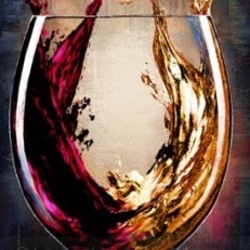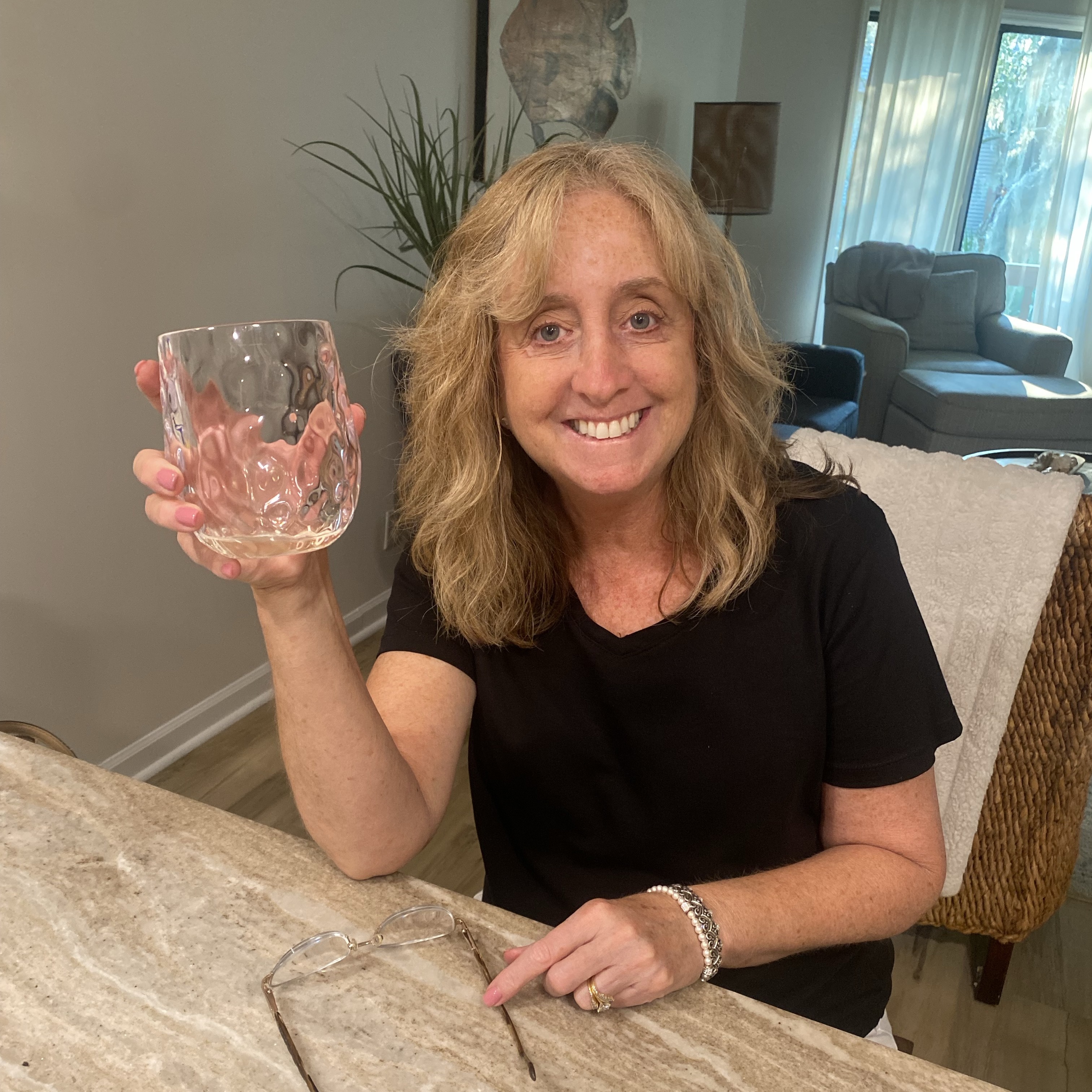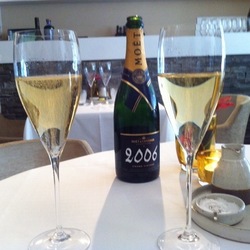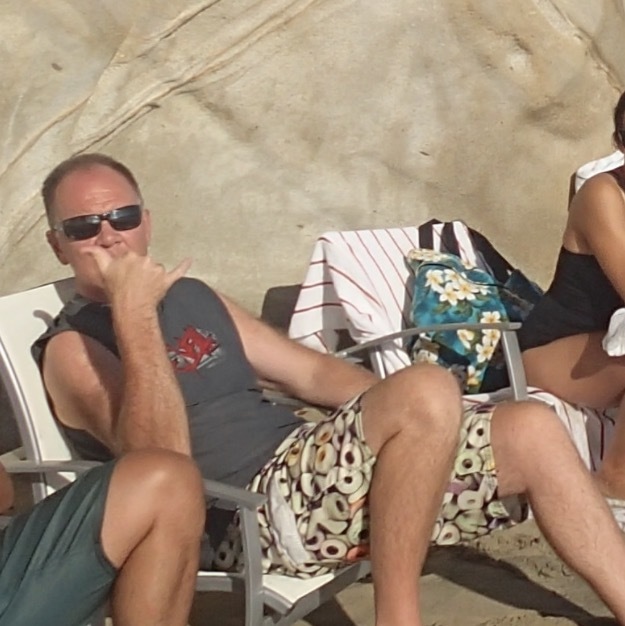Born Rosé Barcelona
Emilio Lustau
Vermut Lustau Rosé
Experiencia Verema Barcelona. Museu Marítim. 2018.
19.11.18 — 7 years ago
Juvé y Camps
Aurora d'Espiells Penedès Rosé 2017
Tapas night in Barcelona, good wine — 7 years ago
Domaine Chandon
California Sparkling Rosé Blend
Been a while since I had a taste. Born in 1973 from the sparkling connection between two pioneers, & settled between the peaks & valleys of northern CA. A blend of Chardonnay and Pinot Noir, Deep pink color with red fruit & tropical aromas. Tiny bubbles, rapid bead flow, the palate shows ripe strawberry & cherry with citrus flavors. The wine has good balance with acidity and smooth mouthfeel. The Pinot Noir gives this sparkler some finesse on the finish ending with toasty notes. Good value! Tasting Sample. — 7 years ago
Krug
Brut Rosé Champagne Blend
There are certain occasions that call for Krug Rosé. So, HBTM! The bottle was corked in the summer of 2014. It’s a blend of 45 reserve wines with the oldest being from 2007 and the youngest 2002. This is why I think Champagne Makers are some of the most talented people making wine. They are constantly blending up to 100 plus wines to bring that bottle to bottle and year to year branded flavor of consistency. On the nose; red & pink spring flowers, cherries, strawberries, watermelon, black cherry, black raspberries, notes of blood orange citrus, baked bread, soft volcanic mineral and elegant chalkiness. The palate is always ridiculously delicate. Micro bubbles, silky rich texture with beautiful soft acidity. The palate fruits are similar to the nose; rich & ripe cherries, strawberries watermelon, black cherry, black raspberries, notes of blood orange citrus with hints of marmalade. Red & pink spring flowers, baguette crust, soft powdery minerals that give the palate a slight sting and super powdery chalkiness done just right. The finish is beautifully rich, textured, revealing itself in layers and lasts minutes. Photos of; Founder Joseph Krug, House of Krug, Winemaker Eric Lebel, Krug’s Clos du Mesnil, a small plot of 1.85 hectares of Chardonnay...one of the world’s greatest vineyards and their salon tasting room. Producer history & notes...Krug was founded by Joseph Krug in 1853. They are based in Reims, the main city in France’s Champagne region. It is one of the famous Champagne houses that formed part of the Grande Marques. Today the house is majority owned by the multinational conglomerate LVMH, which owns Moët Hennessy, Louis Vuitton S.A. and who’s wine producer portfolio includes other well known wine brands such as; Moët & Chandon, Veuve Clicquot, Château d'Yquem, Ruinart & Cheval Blanc, Dom Perignon and many others. Despite LVMH's majority ownership, the family is still actively involved in all the key decisions of the house but does not manage the day-to-day operations. Joseph Krug was born Johann-Joseph Krug, a butcher’s son, in Mainz, on the Rhine in 1800 when the city was part of the Napoleonic Empire. Having dispensed with the name Johann, he left Mainz in 1824 and in 1834 moved on to Paris. Germans were in demand in France as accountants and bookkeepers. So, Joseph joined Champagne Jacquesson in Châlons-sur-Marne. He spent eight years with Jacquesson. His work took him beyond accountancy. He went around Europe testing the market and assessing criticism from wine sellers and customers. He learned about composition and taste so that by 1840 he already seemed to have been blending Champagne for at least one other house. In 1841, he married Emma-Anne Jaunay. The daughter of a French hotelier based in London’s Leicester Square. The following year their son Paul Krug was born. In 1842 he moved to Reims and following a year later, Krug et Cie was founded with his partner, Hyppolite de Vivès. Joseph was fluent in French, English and German and even spoke some Russian, putting the company in position to exploit key overseas markets. Joseph died in 1866 and was succeeded by his son Paul Krug, who had been trained by his father to takeover. Joseph under the supervision of Paul, Krug was established as a Grande Marque. By the 1880s the prestige of Krug was acknowledged in the United Kingdom and became the primary overseas market for Champagne. In 1866, the House moved into Rue Coquebert, in Reims as it remains. After Paul’s death in 1910, he was succeeded by his son, Joseph Krug II. However, during World War I Joseph II was taken prisoner and his wife Jeanne played a key role in the House at a time when the Western Front divided the region between the Allies and the Germans. After the war, Joseph II’s slow recovery led to his nephew Jean Seydoux becoming joint manager in 1924. In that decade, the Krug 1926 and 1928 vintages were created, which have been considered by critics to be amongst the greatest Champagnes. Lawyer and wine writer Maurice Healey declared “Krug” the king of all Champagnes. Further, “that the 1928 Krug was the best wine made in the present century.” By the mid-1930s, Paul Krug II, the son of Joseph II, was active in the business and would become head of the House from 1959 to 1977. His father died in 1967, by which time he was, according to Patrick Forbes, “one of the most popular and respected figures in the Champagne district.” In 1962 Henri Krug, the son of Paul II, joined the management, as did his brother Remi three years later. Their arrival was followed by a series of innovations, including extensions in the range of Champagnes. In 1979, for the first time, a graduate winemaker joined the House. In January 1999, the House became part of LVMH and by 2007, the brothers, while remaining on the tasting committee, had stepped down from day-to-day responsibilities. In 2009 Olivier Krug, the son of Henri, became House Director. At harvest, Krug grapes are pressed close to their plots with the first juice kept for 24 hours in a vat prepared for the fermentation stage. The pressing from each plot is vinified separately. A pressing contains 4,000 kilos of grapes and yields 20.5 hectolitres of first juice (cuvée), which is poured into twelve oak casks chosen at random. Once fermentation is complete, the eleventh and twelfth casks are used to top up the other ten casks in order to protect the new wines from oxidation. For fifteen days, each cask is topped up with wine from the same plot. Krug uses small 205 liter oak casks tailor-made from trees that are more than two centuries old in the forests of Hautes Futaies in Central France. The average age of Krug oak casks is 20 years. They are retired after approximately 40 years of use. The wines remain in the casks for several weeks. During this period, clarification occurs naturally from the cool temperature of the cellar given the coming winter, as does a micro-oxygenation process from the use of natural containers, making the wine more resistant to oxygen over time. Finally, between December and January, the wine is drawn off into small stainless-steel vats. From here, depending on the decisions of Krug’s tasting committee, the wines will either contribute to that year’s assemblage or be stored in steel vats in the House’s library of 150 reserve wines to be used in the blend of a future Krug Grande Cuvée and or Krug Rosé. — 8 years ago


Bodegas Ramón Roqueta
Cabernet Sauvignon 2015
Relaxing in A Cozy Born Barcelona apartment! 🇪🇸💃🍷 — 9 years ago
Pehu Simonet
Face Nord Grand Cru Rosé Champagne
Experiència Verema Barcelona. Museu Marítim.
25.11.19 — 6 years ago
Tarlant
Brut Rosé Champagne
Experiencia Verema Barcelona. Museu Marítim. 2018.
19.11.18 — 7 years ago
Bodega Rezabal
Getariako Txakolina Txakoli Rosé 2017
Had at Barcelona girls weekend 2018 — 7 years ago
Bedrock Wine Co.
Ode to Lulu California Old Vine Rosé Blend
It might shock you, but my favorite rosé is not French but instead comes from California! Blasphemy, I know - but Bedrock's Ode to Lulu is just that good. The difficulty is actually finding a bottle. For the last three years, I've only been allocated a case (or less) to sell here in Denver. It's possible you are one of the select few I've actually told about this wine... If not, now is your chance. This is the first year there's an "okay" supply. It won't last, but you should be able to get a bottle.
So yes, it's not French but it's made in the same style and method of Tempier Bandol Rosé- the most sought after, cult rosé out there. The name "Ode to Lulu" is actually an homage to the 4.5 foot tall, 101 year old woman named "Lulu" Peyraud (born Lucie Tempier) whose father gifted the Mourvedre heavy estate to her and her husband Lucien Peyraud. The wines they would go on to produce from the 1940's onward quite literally defined Bandol and put it on the map as some of the best rosés out there. She's still alive and presumably drinking plenty of wine.
This California-born "Ode to Lulu" is modeled after the great Tempier, but has some unique properties compared to it's French namesake. For one, the vines are EXTREMELY old. Tempier defined itself by focusing on old Mourvèdre and Grenache plantings, but even these French vineyards cannot compare to what Bedrock is working with in California. If you don't know, Bedrock is the winery of Morgon Twain Peterson, son of legendary Ravenswood founder Joel Peterson. Morgon grew up making wine and through his father has cultivated relationships with some of the most important heritage vineyards in California. The "Ode to Lulu" is made from Mourvèdre and Grenache planted as far back as 1888! These are some of the oldest plantings of these grapes around and make for unbelievable wines. Tempier's average vine age is around 40 years old today. Bedrock's is over 3x as old. Insane.
Morgon may be young, but he has a life time of winemaking experience. He started making wine with his father when he was 5 years old and hasn't stopped yet. In addition to absorbing his father's knowledge on heritage vineyards, he is a real student in the world of wine, earning a "Masters of Wine" designation (this industry's highest achievement). I've been drinking his wine for several years and I can say that his wine is made extremely thoughtfully and with expert attention to detail. This is true even with a wine as humble as rosé.
Unlike most California pink wine, Bedrock is not produced by "bleeding off" juice from a red wine. Instead, the grapes are picked early and separately at very low potential alcohols, and whole cluster pressed with low extraction. This preserves the freshness and acidity, creating a wine of clarity. In an old blog post I dug up, Morgon explains this idea:
"I pick at potential alcohols lower on the scale where brightness and lift still exist. This is not to say that fruit does not matter—I use Mourvedre from a block planted over 120 years ago for requisite concentration of complexity of flavor—but like fine champagne, the wonders of rosé lie in its unbearable lightness of being."
I agree with this idea of rosé and I think most people instinctively do as well. It's no coincidence that our best selling bottles come from provence. However, I urge you to pick up at least one bottle of this Ode to Lulu. It's a wine that's close in spirit to the best French rosé but made from vineyards that are American and unrivaled in age.
This is the fourth vintage of Ode to Lulu I've tasted, and I would say that's the most elegant yet. The 2015 was maybe my favorite for it's depth and I picked a few up to age, drinking my last bottle recently... This new vintage is great now, but it will reward with a short cellaring time. Honestly, if you can hide 2 bottles and drink them before fall or into next year, you will be blown away. Bandol rosé is a wine that improves dramatically over the course of 6 months to several years (Tempier Rosé is known to go decades). This bedrock is no different.
I can personally attest to past vintages gaining depth with time. How is this possible? Unlike other rosé which should be drank young, Bandol and Ode to Lulu are made of Mourvedre, a grape that is naturally reductive and resistant to oxidation. Further, the acidity is high and alcohol low. As the acidity starts to fall away, a depth and richness of character will emerge. In fruitier/riper rosé with more alcohol, this richness becomes too sweet and cloying... Not the case here. This keep balanced through time, gaining complexity while remaining refreshing.
You should buy this wine. However, I think there is one more important facet to rosé that I should mention before you do... Rosé is not always about what's in the glass itself. Rosé is really an ethereal thing... It's more so an "essence" of terroir and vintage rather than a sturdy, hard representation like red wine is... Sorry if that doesn't make sense but what I'm trying to say is that sometimes rosé is more about the place and the people you enjoy it with than the exact flavors themselves. Of course, we cannot all visit the picturesque village of Bandol to visit Lulu Peyraud; but I think, with this sunny Colorado weather, we can come close. Perhaps Morgon said it better than I can:
"Proper rosé is refreshing, life-nourishing stuff that revives the soul... I drink as much for pure pleasure as for intellectual stimulation. In the warmer months there is something sacred about a late afternoon meal of cold chicken, fresh garden tomatoes, and rosé. It is one body in the sacred trilogy of rustic simplicity." - Morgon Twain Peterson
#rose #oldvine #lulu #tempier #bedrockwineco — 7 years ago
Vilarnau
Barcelona Reserva Brut Rosé Blend
This fun bubbly brings the brut. It's Sahara dry, with a strong earthy and yeasty streak running through it. The unusual grape - Trepat - comes on with some of the earthiness of a North American variety, and provides a nice counterpoint to the Pinot Noir. It's my first time to taste Trepat, by the way, and I would do it again. Minerals all over the strawberry aromas and flavors hit very well, and provide food friendliness. Nice price alert: $16 — 8 years ago
Celler Barcelona
Catalunya Rose
My new favorite rosé — 8 years ago
Gran Caus
Brut Pinot Noir Rosé
With Marco in Barcelona — 8 years ago
Raventos i Blanc
De la Finca Conca del Riu Anoia Barcelona Macabeo-Xarel-lo-Parellada 2014
Beautiful sparkling rosé — 9 years ago
Chic
Barcelona Rosé Blend
Pretty tasty for a free glass! — 6 years ago
Robert Stemmler Winery
Vin Gris Pinot Noir Rosé 2015
Barcelona Restaurant. Excellent, dry. — 7 years ago
Gérard Bertrand
Cote des Roses Languedoc Grenache Blend 2017
Gerard Bertrand was born and raised in the South of France, making wine with his father, Georges, since the age of 10. Went to a private Rosé tasting and this was one of the better ones. Deep pink with fruit, floral and citrus aromas. Palate shows peachy notes with citrus tones, fresh and crisp. A tad drying on the finish ending with fruit character. Nicely balanced. Tasting Sample. — 7 years ago
Château de Campuget
1753 Costières de Nîmes Syrah Vermentino Rosé 2016
At Barcelona bar. Delicious. — 8 years ago
Bollinger
Brut Rosé Champagne Blend
On the nose; bright cherries, ripe strawberry & cranberry reduction, black raspberries, raspberries, watermelon near the rhine, mixed orange citrus, oyster shells, baguette crust, understated volcanic minerals, chalk, saline, fresh pink roses and florals. The body is full and a shade gluey. The fruits are ripe, rich and candied/gummy in style. Bright cherries, black cherries ripe strawberry & cranberry reduction, black raspberries, raspberries, watermelon near the rhine, mixed orange citrus spray, saline, seashells, soft grey volcanic minerals, lots of grippy powdery razor sharp chalkiness, baguette crust, fresh pink roses & florals, acidity that is round and well done, understated delicate micro bubbles and a long, well balanced, rich finish. The reason why I prefer the Billecart Salmon, Ruinart & Laurent Perrier over the Bollinger is it’s a little too sweet for me. Photos of; the House of Bollinger, cellar, headstone that marks one of their vineyards and their harvest staff picking perfectly manicured rows. Producer notes and history...Bollinger has roots dating back to 1585 when the Hennequins, one of the Bollinger founding families, owned land in Cramant. Before the Bollinger house was founded in the 18th century, the Villermont family practised wine making, though not under their family name. In 1750, Villermont settled at 16 rue Jules Lobet, which would eventually become the head office for Bollinger. In 1803 Jacques Joseph Placide Bollinger was born in Ellwangen, in the kingdom of Württemberg. In 1822, he moved to Champagne and found work at the house of Muller Ruinart, which no longer exists. Many other Germans came to settle in the Champagne region, including Johann-Josef Krug and the Heidsiecks, who founded a house that would become; Charles Heidsieck, Piper Heidsieck, Veuve Clicquot and others. The Champagne house Renaudin Bollinger was founded in 1829 in Aÿ by Hennequin de Villermont, Paul Levieux Renaudin and Jacques Bollinger. The partners agreed that the Villermont name would not be used on the labels, hence the house name Renaudin Bollinger. Starting when Jacques Bollinger married Charlotte de Villermont, the house has been managed by the Bollinger family. Even though Paul Renaudin passed without an heir to his name, the label did not become solely Bollinger until the 1960s. Founder Jacques Joseph Bollinger married Charlotte de Villermont. The had a daughter, who had two sons Joseph and Georges. These sons took over the company in 1885 and began expanding the family estate by purchasing vineyards in nearby villages. The sons also developed the image of the brand, such as when Bollinger became the official supplier to the British court and received a Royal Warrant in 1884 from Queen Victoria. In 1918, Jacques Bollinger, the son of Georges, took over the company and married Emily Law de Lauriston Boubers, known as "Lily". Jacques expanded the facilities by building new cellars, purchasing the Tauxières vineyards, and acquiring the assets of another Champagne house on Boulevard du Maréchal de Lattre de Tassign, where Bollinger's offices are presently located. When Jacques Bollinger died in 1941, Lily Bollinger took over. Lilly expanded production with the purchase of even more vineyards, but is best known for traveling the world to market the brand. Bollinger was modernized under the Claude d'Hautefeuille, who acquired additional vineyards and further developed the brand internationally. Following Claude, his cousin Christian Bizot took over the Bollinger house and expanded world distribution. Their Winemaker also used several James Bond film movies to market the brand. Bollinger is fermented in oak barrels. At harvest, only the first pressing is used in the cuvée, unless the vintage is of particularly high quality, when a second pressing of Chardonnay will be used. Bollinger sells the second pressing, the tailles. Bollinger utilizes two pressing houses (Louvois and Mareuil sur Aÿ) to ensure a short distance between harvest location and pressing. When possible, grapes purchased from growers are pressed by the house. When the pressed wine arrives, the Bollinger cellar master analyzes the musts for quality, discarding and selling off those that do not meet the house standards. The first fermentation is done cru by cru, variety by variety, preserving many of the unique characteristics of the vines location. Bollinger is one of the few Champagne houses to do some first fermentation in oak barrels. Wines that will not hold up to first fermentation in wood are vinified in vats. Bollinger Champagnes usually undergo malolactic fermentation. The Grande Année 1995 did not undergo malolactic fermentation. Bollinger uses only traditional yeast. They’ve decided that new generations of yeasts (agglomerated yeasts and encapsulated yeasts) do not produce satisfactory Champagne. Vintage wine, including all wine to be used in a Grande Année, is fermented in small oak barrels, sorted according to origin and variety. Both oak and stainless steel are used for non-vintage wine. Bollinger also has the last Cooperage in Champagne. The oak barrels are all at least four years old, avoiding the transfer of tannins to the wine. The wines are only lightly filtered. All Bollinger Champagne spends a long time on its lees, contributing to the complex flavour of the wine. Though appellation d'origine contrôlée rules only require 12 months on lees for non-vintage Champagne and for vintage (NV wines, 15 months from tirage to release and vintage wines must be kept for 36 months from tirage to release), Bollinger ages their non-vintage wines three years, and the vintage wines from five to eight years. The Grande Année and R.D. Champagnes are riddled by hand. At disgorgement, Bollinger wines are given a low dosage, to maintain the balance and flavor of the wine. The company uses 6-9 grams of sugar per liter for the Special Cuvée and La Grande Année. The extra-brut R.D. is dosed between 4 and 5 grams. After dosage, the wines are aged an additional several months, resting for a minimum of three months before shipping. Bollinger owns nearly 160 hectares of vines, producing more than 60% of its supply. The vines are largely Pinot Noir, specifically clone 386. Bollinger believes this clone ensures good quality as well as highlighting characteristics of the various terroirs. The vineyards also include some rare ungrafted French vines from before the phylloxera. Bollinger owns vines all over Champagne, including the crus of Aÿ, Bouzy and Verzenay. — 8 years ago

I figured a real keyboard needed to be involved, thanks for the insight.













Jordi Pazo
Vella Terra, Fira Independent del Vi Natural de Barcelona. Estació del Nord.
09.02.20
— 6 years ago